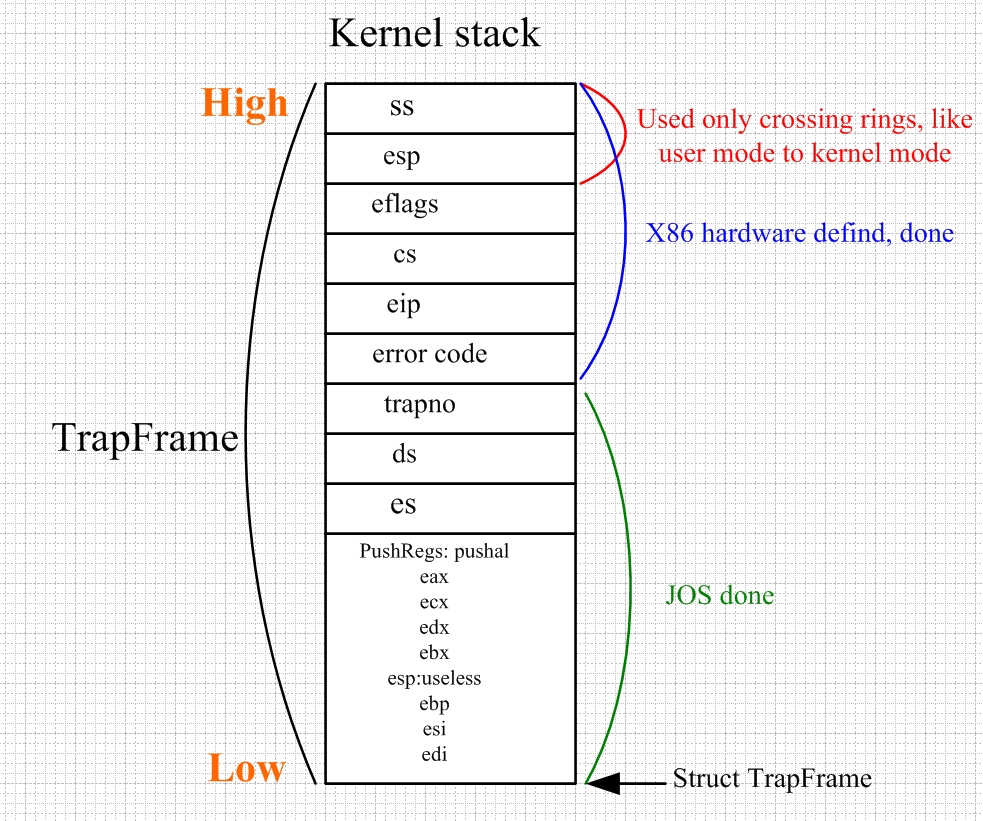两个模式切换涉及两个很重要的数据结构:Taskstate和TrapFrame,Taskstate前面已提到,这个在cpu初始化时会调用trap_init_percpu将设置这个结构体中的栈寄存器和段寄存器: tss->ts_esp0 = 每个cpu的栈top; tss->ts_ss0 = GD_KD; 内核的数据段选择子
每个cpu都有一个这样的结构:thiscpu->cpu_ts,这个是为了当从用户态切换到内核态时,让cpu能找到内核栈和数据段的地址。
TrapFrame用在内核态与用户态相互切换时,当从user mode切换到kernel mode时,cpu会将当前进程的状态信息以TrapFrame的形式 保存在cpu的内核栈上(内核栈地址由上面的tss给出),而当cpu从kernel mode返回时,会从内核栈上pop出进程的状态信息,然后继续进程的运行。 下面从两种模式切换时trapframe的作用。
1) 从user mode到kernel mode
发生这种切换时,内核也必须保存当前用户进程的状态,以便返回时可以继续执行,用户进程的状态就保存在TrapFrame结构中, 那么cpu是怎么做的呢? 先看TrapFrame结构:
struct PushRegs {
/* registers as pushed by pusha */
uint32_t reg_edi;
uint32_t reg_esi;
uint32_t reg_ebp;
uint32_t reg_oesp; /* Useless */
uint32_t reg_ebx;
uint32_t reg_edx;
uint32_t reg_ecx;
uint32_t reg_eax;
} __attribute__((packed));
struct Trapframe {
struct PushRegs tf_regs;
uint16_t tf_es;
uint16_t tf_padding1;
uint16_t tf_ds;
uint16_t tf_padding2;
uint32_t tf_trapno;
/* below here defined by x86 hardware */
uint32_t tf_err;
uintptr_t tf_eip;
uint16_t tf_cs;
uint16_t tf_padding3;
uint32_t tf_eflags;
/* below here only when crossing rings, such as from user to kernel */
uintptr_t tf_esp;
uint16_t tf_ss;
uint16_t tf_padding4;
} __attribute__((packed));
上面这些值(主要是寄存器)就是cpu从用户态切换到内核态需要保存的(PushRegs里面的通用寄存器是用于向内核传递参数,如系统调用号就是用eax传递的,返回值也是eax;然后是段寄存器,cs:eip用于返回时继续执行)。切换的入口在trapentry.S中: 以系统调用的代码为例: 这个handler_sysall的代码:
#define TRAPHANDLER_NOEC(name, num) \
.globl name; \
.type name, @function; \
.align 2; \
name: \
pushl $0; \
pushl $(num); \
jmp _alltraps
下面是_alltraps的代码:
.globl _alltraps
.type _alltraps, @function
.align 2
_alltraps:
pushl %ds
pushl %es
pushal
movw $GD_KD, %ax
movw %ax, %ds
movw %ax, %es
pushl %esp
call trap
addl $4, %esp
.globl trapret
trapret:
popal
pop %es
pop %ds
addl $0x8, %esp
iret
_alltraps中会调用trap()函数,我们知道trap函数的参数TrapFrame,所以这个TrapFrame参数是在前面两段汇编代码里面传进去的,现在好办了,只要看看这些汇编代码是怎么处理栈(参数是通过栈传递)? 由于栈是从高地址往低地址生长,所以入栈的顺序应该与寄存器在TrapFrame的位置顺序相反: 也就是从call trap指令往上看,先pushal,这个对应将PushRegs入栈,然后es,ds,再到num,0为止。tf_trapno后面的值都不是这里操作的。 TrapFrame的结构如下图所示:

2) 从kernel mode到user mode
从中断(如缺页,外设中断)返回时,或者从系统调用返回时(excptions发生时,用户进程会被终止)。下面先说一种情况,就是cpu调度一个新的进程运行, 此时一般是先从user mode到kernel mode,然后从kernel mode再到user mode,只是换了一个新的进程在执行。什么情况会出现这种情况呢?常见的就是用户进程执行某个系统调用阻塞了 (如以阻塞方式读取网络设备的数据,数据还没ready,或者等待某个信号量,或者sleep),此时cpu会调度另外一个进程运行。JOS中sched_yield实现了进程调度,而完成从kernel mode到user mode切换的就是其中的env_run(new_process):
if (curenv != NULL) {
if (curenv->env_status == ENV_RUNNING)
curenv->env_status = ENV_RUNNABLE;
}
curenv = e;
curenv->env_status = ENV_RUNNING;
curenv->env_runs++;
lcr3(PADDR(e->env_pgdir));
unlock_kernel();
env_pop_tf(&cunv_tf);
上面env_run先判断是否发生了进程切换,如果是则将当前进程设为RUNNABLE,然后将curenv设为新的进程,再加载新进程的地址空间,解锁big kernel lock,再调用env_pop_tf来恢复新进程的状态(继续上一次的运行指令):
__asm __volatile("movl %0,%%esp\n"
"\tpopal\n"
"\tpopl %%es\n"
"\tpopl %%ds\n"
"\taddl $0x8,%%esp\n" /* skip tf_trapno and tf_errcode */
"\tiret"
: : "g" (tf) : "memory");
上面就是env_pop_tf的代码,实际上就是将之前保存在内核站的TrapFrame再pop出来完成了切换到用户进程。